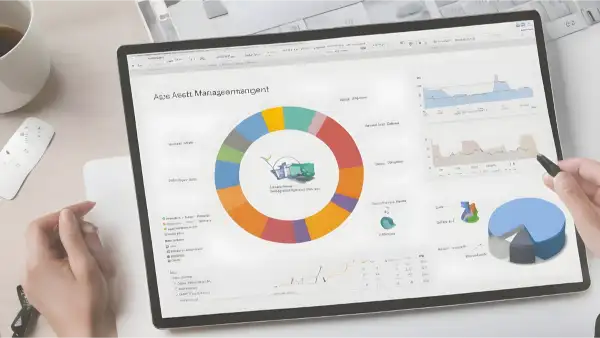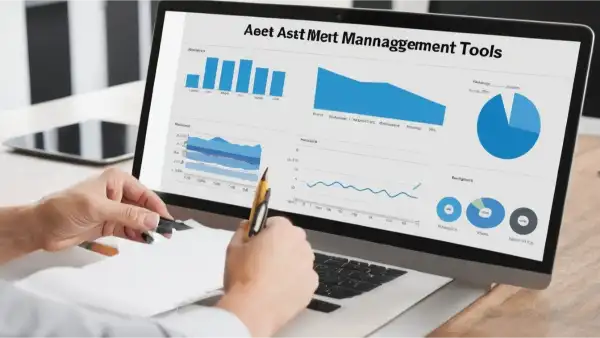Digital Asset Management Tool
A digital asset management tool is a software solution. It helps businesses organize, store, and retrieve their digital content. This includes images, videos, audio files, and documents. This type of software organizes all digital assets. It acts as a centralized library. It often includes features for tagging, categorizing, and searching content. This makes it easy to find and access specific files.

Digital asset management tools streamline the process of managing large volumes of digital content. They save time and reduce the likelihood of misplacing important files. This is especially useful for marketing teams, creative professionals, and media companies. They regularly work with a lot of digital media. The software improves collaboration and efficiency. It ensures that all team members have easy access to the latest, most relevant assets. Additionally, it helps in maintaining brand consistency across various platforms. It provides a single source for all brand-related digital assets.
What are the benefits of using a digital asset management tool?

Some of the benefits of using a digital asset management tool are:
It reduces the cost and time of creating, storing, and distributing digital assets.
It enhances the quality and security of digital assets. It prevents duplication, corruption, and unauthorized access.
It increases the productivity and creativity of teams. This is by facilitating the sharing and reuse of digital assets.
It enables businesses to integrate and automate digital workflows. This supports their digital transformation and innovation.
What are the features of a good digital asset management tool?

Some of the features of a good digital asset management tool are: Click here to know about digital asset management jobs
It supports various types and formats of digital assets. These include images, videos, audio files, and documents.
It provides a user-friendly and intuitive interface. Users can upload, organize, and manage digital assets.
It allows users to add and edit metadata, such as keywords, descriptions, and tags. This improves the searchability and discoverability of digital assets.
It offers advanced search and filtering options. Users can find and access the digital assets they need.
It enables users to preview, edit, and convert digital assets within the tool. It does not need external applications or plugins.
It facilitates collaboration and communication among team members and stakeholders. It allows them to share, comment on, and rate digital assets.
It integrates with other tools and platforms, such as cloud storage and social media. It also works with content management systems. This streamlines the distribution and delivery of digital assets.
It provides analytics and reports on the usage and performance of digital assets. It shows views, downloads, and conversions.
It enforces access and usage rights, permissions, and policies. This ensures the compliance and governance of digital assets.
What are some examples of digital asset management tools?
Some examples of digital asset management tools are:
Adobe Experience Manager Assets:
This is a cloud-based digital asset management solution. It helps businesses create, manage, and deliver engaging digital experiences across different channels and devices.
IBM Digital Asset Manager:
This solution is scalable and secure. It helps businesses optimize the production and delivery of rich media content. It works across many platforms and devices.
Bynder:
This cloud-native digital asset management solution helps businesses create digital content faster. It also helps them find and use digital content faster. It also makes it easier.
The Digital Project Manager:
The website provides reviews and comparisons of various digital asset management software solutions. It also offers tips and best practices for digital project management.
What are some popular digital asset management tools?

Some popular digital asset management tools are:
Adobe Experience Manager:
A cloud-based digital asset management solution helps businesses create, manage, and deliver engaging digital experiences. It does so across different channels and devices.
Brandfolder:
It’s a cloud-native digital asset management solution. It helps businesses create, find, and use digital content faster and easier.
MediaValet:
This is a cloud-based digital asset management solution. It helps businesses securely manage, share, and distribute their digital assets globally.
You can find more information and reviews about these and other digital asset management tools on websites like The Digital Project Manager and [Gartner].
What are the pricing plans for Adobe Experience Manager?
Adobe Experience Manager does not have a fixed pricing plan. It offers customized solutions based on the needs and requirements of each organization. But, some of the factors that may affect the pricing are:
The number of users and assets
The amount of storage and bandwidth
The type and level of support and services
The features and functionalities included in the package
Contact the Adobe sales team to get a personalized quote for Adobe Experience Manager. You can also fill out a form on their website. You can also compare the key capabilities of different Adobe Experience Manager packages on their website. This includes Departmental and Enterprise. Or, you can check out some third-party websites. They provide reviews and comparisons of various digital asset management software solutions. Examples include The Digital Project Manager and [Gartner].
Can you tell me more about Departmental and Enterprise packages?
There are two possible options for deploying Experience Manager as a cloud service. Your choice will depend on your business needs and budget.
Small to medium-sized businesses can use the Departmental package. They need a simple, cost-effective solution for managing their digital content. It offers the following features and benefits:
You can create and manage up to 10 websites using Experience Manager Sites. Each site has a most of 100 GB of storage and 500 GB of bandwidth per month.
It provides you with access to Experience Manager Assets. It is a digital asset management solution. It lets you store and manage up to 10,000 assets. It has a most of 50 GB of storage and 100 GB of bandwidth per month.
It enables you to use Experience Manager Forms. The solution helps you create and deliver interactive forms and documents. It allows a most of 10,000 submissions per month.
It includes basic support and services. These services include online documentation, community forums, and email support.
Large and complex businesses can use the Enterprise package. They need a comprehensive and scalable solution for managing their digital content. It offers the following features and benefits:
You can create and manage unlimited websites using Experience Manager Sites. There are no limits on storage and bandwidth.
It provides you with access to Experience Manager Assets. It’s a digital asset management solution. It lets you store and manage unlimited assets, with no limits on storage and bandwidth.
It enables you to use Experience Manager Forms. This solution helps you create and deliver interactive forms and documents. It has no limits on submissions.
It includes advanced support and services. These include online documentation, community forums, phone support, a dedicated account manager, and professional services.
For more details and comparisons of these and other Experience Manager packages, visit their website. You could also contact their sales team.
What are the pricing plans for Departmental and Enterprise packages?
The pricing plans for Adobe Experience Manager’s Departmental and Enterprise packages are not available to the public. Each organization’s needs and requirements customize them. But, some of the factors that may affect the pricing are:
The number of users and assets
The amount of storage and bandwidth
The type and level of support and services
The features and functionalities included in the package
Contact Adobe’s sales team for a personalized quote for Adobe Experience Manager. You can also fill out a form on their website. You can also compare the key capabilities of different Adobe Experience Manager packages on their website. These include Departmental and Enterprise. Or, you can visit third-party websites. They offer reviews and comparisons of different digital asset management software solutions. For example, The Digital Project Manager and Gartner.
Can I switch from one package to another?
Yes, you can switch from one package to another. If you need to change your digital asset management solution, you can do so. But, switching packages may involve some extra costs and steps. This depends on the package you are switching from and to. For example, switching from the Departmental package to the Enterprise package may require more storage and bandwidth. It may also need more support and services.
Switching from the Enterprise package to the Departmental package may need you to manage fewer websites, assets, and forms. You may also need to use fewer features and functionalities.
To switch from one package to another, you need to contact Adobe sales team or fill out a form on their website. They will help you switch packages and provide a personalized quote based on your needs. You can also compare the key capabilities of different Adobe Experience Manager packages on their website.
This includes Departmental and Enterprise packages. Or, you can explore third-party websites. They offer reviews and comparisons of different digital asset management software solutions. For example, The Digital.
Frequently Asked Questions
Which tool is used for asset management?
Asset management involves planning, acquiring, maintaining, and disposing of physical or digital assets. These assets have value for an organization or individual. There are different tools for asset management. The tools depend on the type and complexity of the assets. Some examples are spreadsheets, inventory software, barcode scanners, RFID tags, and digital asset management (DAM) systems.
What is AEM digital asset management?
AEM digital asset management is a cloud-based solution from Adobe. It allows users to create, manage, deliver, and optimize digital assets. These assets include images, videos, documents, and more. Users can use it to reach various channels. It is part of the Adobe Experience Manager suite. The suite also includes content management, personalization, and commerce features.
How are digital assets managed?
Software systems manage digital assets. They provide a systematic approach to store, organize, manage, retrieve, and distribute digital assets. They call these systems digital asset management (DAM) systems. They often include features such as metadata management, version control, permission management, workflow automation, and integration with other platforms.
What are the 3 main asset management types?
The three main types of asset management are financial, infrastructure, and enterprise. Financial asset management refers to the management of investments, securities, and portfolios. Infrastructure asset management refers to the management of physical assets. Examples include roads, bridges, buildings, and utilities. Enterprise asset management refers to managing assets. These assets support an organization’s operations and goals. Examples include equipment, machinery, vehicles, and IT assets.
What are the three tools of asset management?
Asset management has three tools: asset identification, asset valuation, and asset performance. Asset identification assigns unique identifiers and attributes to each asset. These attributes include name, type, location, and owner. Asset valuation is estimating the current and future value of each asset. Factors like depreciation, replacement cost, and market value form the basis for this. Asset performance measures and monitors the condition, functionality, and efficiency of each asset. This is based on metrics like availability, reliability, and quality.
What type of asset are tools?
People use tools to perform tasks, create products, or provide services. Tools can be physical or digital. They can have different complexity and functionality levels. Some examples of tools are hammers, scissors, software, apps, etc.
Is asset management part of ERP?
Asset management can be part of ERP (enterprise resource planning), but it is not always the case. ERP is a software system that integrates various business processes and functions. These include accounting, inventory, sales, and human resources. Asset management can be one of the modules or components of an ERP system. Or, a separate system can integrate with the ERP system. The choice depends on the needs and preferences of the organization.
Is Google Drive a DAM?
Google Drive is not a DAM. However, users can still use it for basic file storage and collaboration. Google Drive is a cloud-based service. It allows users to store, sync, and share files across devices. It is mainly designed for personal or small team use. It offers some basic features, such as folders, search, and sharing. However, it lacks advanced features typically needed for comprehensive digital asset management. These include robust metadata management, version control, and permission management. They are essential functionalities for dedicated DAM systems.
What is an example of digital asset management?
A media company uses a DAM system to store, organize, and distribute its digital assets. These include photos, videos, audio files, and articles. This is an example of digital asset management. The DAM system helps the company manage its large and diverse library of digital content. It ensures that the right assets are available and accessible to the right people at the right time. The DAM system helps the company maintain brand consistency. It also optimizes content creation and improves customer experience.
What are examples of digital assets?
Digital assets are files or data stored digitally. These items hold value and people can transfer or use them. Some common examples include digital assets related to cryptocurrency and blockchain technology. For example, cryptocurrencies, non-fungible tokens (NFTs), and smart contracts. Other examples include digital media and entertainment assets, such as images, videos, audio files, e-books, and games.
